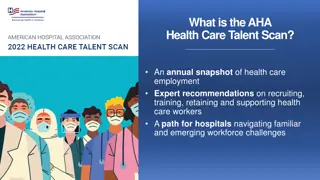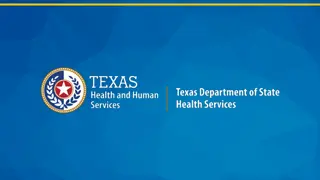Blueprint for Strengthening Pennsylvania's Direct Care Workforce
Pennsylvania Long-Term Care Council presents a blueprint to address the worsening crisis faced by the state's direct care workers, emphasizing the workforce shortage, low wages, and economic insecurity. The report highlights the challenges, including the physical and emotional demands of the job, and advocates for improved pay, benefits, and training to enhance recruitment and retention in the field. Testimonials from direct care workers underscore the importance of valuing and supporting this vital workforce.
Download Presentation

Please find below an Image/Link to download the presentation.
The content on the website is provided AS IS for your information and personal use only. It may not be sold, licensed, or shared on other websites without obtaining consent from the author. Download presentation by click this link. If you encounter any issues during the download, it is possible that the publisher has removed the file from their server.
E N D
Presentation Transcript
Pennsylvania Long-Term Care Council A Blueprint for Strengthening Pennsylvania s Direct Care Workforce October 8, 2019 Long-Term Services and Supports Subcommittee
A BLUEPRINT FOR STRENGTHENING PENNSYLVANIA S DIRECT CARE WORKFORCE The Worsening Crisis Pennsylvania s Direct Care Workers The Workforce Shortage Wages Economic Insecurity The Approach Recommendations 2
THE WORSENING CRISIS PA faces a growing direct care worker crisis due to a shortage of workers and high turnover. This volatility impacts consumers access to and the quality of long-term services and supports (LTSS). A multitude of factors contribute to the shortage of workers and the high turnover, including the nature of the work (physically and emotionally challenging), low wages, minimum training, lack of advancement opportunities and respect, etc. I became a home care worker out of a deep desire to help others. The connection I was able to form with clients and helping them prevent larger problems by reporting changes were some of the most rewarding aspects of my job. However, like so many other direct care workers, I found it challenging to provide for myself and my family in this job. Better pay, benefits, and training, including opportunities for career advancement, are needed to address barriers for recruitment and retention, as well as enhancing the respect of this profession both in society and among health care professionals. Ann Pannone, 2017 Pennsylvania Direct Care Worker of the Year & 2017 Bayada National Home Health Aide of the Year 3
PENNSYLVANIAS DIRECT CARE WORKERS A variety of names and titles used to refer to direct care workers (DCWs) DCWs provide the vast majority of paid hands-on care, services, and supports to consumers across the long-term services and supports (LTSS) continuum Over 219,000 DCWs in Pennsylvania across all industries, with most employed in LTSS Vast majority of DCWs providing LTSS are women with a median age of 40 4
THE WORKFORCE SHORTAGE Over 37,000 more DCWs will be needed by 2026 This does not account for vacancies due to turnover Pennsylvania has the fifth oldest population in the nation and the fifth largest population of residents with disabilities Approximately 70% of people turning 65 on average will need some type of LTSS during their lives Pennsylvania's age dependency ratio continues to increase. 5
WAGES 6
THE APPROACH Review of previous reports and studies Discussions w/ DCWs and providers across the LTSS continuum, including consumer input Presentations by CHC-MCOs Overview of state and local workforce development system and current challenges to elevating the DCW profession Consultation with the Paraprofessional Healthcare Institute 9
RECOMMENDATIONS & STRATEGIES AWARENESS & OUTREACH Goal: Raise awareness of the important role of direct care workers in serving older adults and individuals with disabilities and the link between a strong workforce and access to and quality of LTSS Recommendation: Create a statewide public awareness campaign and targeted events to both emphasize the need to recruit and retain more workers and the value of these professionals Strategies: Creation of a public awareness campaign Statewide Direct Care Worker Day and Take an Elected Official to Work Day 10
RECOMMENDATIONS & STRATEGIES, CONTD STANDARDIZED TRAINING & CAREER PATHWAYS Goal: Better equip direct care workers to meet the challenges of the profession, while providing opportunities for career development and advanced roles Recommendation: Establish a standardized core training and credentialing system for direct care workers, which provides career pathways throughout the continuum of LTSS Strategies: Establishment of a training advisory workgroup to develop a model training for curriculum personal care aides/attendants and career pathways (tiered stackable credentials via bridge curriculums) for direct care workers who wish to become a home health or nurse aide Pilot testing model curriculum, etc., w/ CHC-MCOs and providers, including data collection Make necessary adjustments based on data and outcomes, and establish a uniform statewide training and credentialing system Explore potential funding sources and take action to assist with cost of training both within and outside of the Medicaid Program 11
RECOMMENDATIONS & STRATEGIES, CONTD LIVABLE WAGES Goal: Provide direct care workers (DCWs) a living wage to help meet their basic needs, thus enabling more individuals to enter and remain in the profession Recommendation: Establish a minimum starting wage of $15 an hour for direct care workers by 2025, with annual increases thereafter indexed to inflation Strategies: The primary strategy for this recommendation entails: establishing a $12 an hour minimum starting wage for all direct care workers beginning with the Fiscal Year 2019-2020 state budget, increasing by 50 cents each year until reaching $15 an hour in 2025 and adjusting for inflation annually thereafter; and raising Medicaid reimbursement rates and other state-supported payments for providers across the LTSS continuum in parallel with the minimum wage increases Develop and implement CHC-MCO rate design and value-based purchasing options focused on DCW retention, which includes opportunities to increase DCW wages 12
RECOMMENDATIONS & STRATEGIES, CONTD DATA COLLECTION Goal: Quantify the impact of direct care worker shortages/turnover and strategies to strengthen the workforce and improve consumer outcomes Recommendation: Implement standardized data tracking, reporting, and training of direct care workforce quality indicators across long-term services and supports (LTSS) settings Strategies: The primary strategy calls for establishing a uniform reporting system to collect data on key direct care workforce quality indicators by initiating pilot projects with the CHC-MCOs Once pilot projects conclude, make needed adjustments and require DCW quality data collection as part of contracts with CHC-MCOs Utilize lessons learned to determine how best to collect data from entities providing LTSS through other state-funded or administered programs 13
RECOMMENDATIONS & STRATEGIES, CONTD CARE TEAM INTEGRATION Goal: Enhance workplace culture and consumer outcomes by fully utilizing the skills and knowledge of direct care workers Recommendation: Require integration of direct care workers into person-centered planning teams by long-term services and supports (LTSS) providers and health plans Strategies: Require providers across the LTSS continuum to include DCWs on person-centered planning teams and include this as: a requirement of the commonwealth s contracts with the Community HealthChoices Managed Care Organizations and allow Medicaid home care providers to bill for the time direct care workers spend in care planning meetings a condition for licensure for all LTSS providers 14
RECOMMENDATIONS & STRATEGIES, CONTD TECHNOLOGY UTILIZATION Goal: Enhance the utilization of technology to assist direct care workers in providing quality services and supports and to help alleviate staffing demands by empowering participants with greater options for self-care to maximize their independence and safety Recommendation: Expand the availability and coverage of technology supports for both direct care workers and LTSS participants by improving the dissemination of information on technology for direct care and providing greater investment in existing state supported programs Strategies: Require CHC-MCOs to submit annual plans to DHS on their efforts to implement and expand the availability of technology, collect data to measure the impact of technology, identify emerging technologies, and provide appropriate training Enhance the strength of current state assistive technology by allocating additional funding in state budget Invest in state broadband to ensure that DCWs and consumers throughout Pennsylvania can fully utilize technology options 15
RECOMMENDATIONS & STRATEGIES, CONTD EXPAND LABOR POOL & INFORMAL/VOLUNTEER SUPPORTS Goal: Expand the pool of potential workers, informal caregivers, and volunteers to assist those in need of services and supports with maintaining their independence Recommendation: Implement incentives to encourage college students to enter the direct care workforce and for students, volunteers, and others to provide supports and assistance to older adults and individuals with disabilities Strategies: Provide loan forgiveness, tuition assistance, etc., for college students who commit to work as a DCW for a certain period of time Provide housing stipends to students who are vetted and reside with an older adult or person with a disability in exchange for helping with instrumental activities of daily living (e.g., shopping, cleaning, etc.) Provide tax credits or rebates for individuals who assist neighbors and others at no charge with services and supports (e.g., lawn care, snow removal, home maintenance, etc.) to help them remain at home, as well as to those who volunteer with programs that provide similar services and supports and companionship 16
CONTACT INFORMATION Charles W. Quinnan Executive Director Pennsylvania Long-Term Care Council Director of Intergovernmental Affairs Pennsylvania Department of Aging 555 Walnut Street, 5th Floor Harrisburg, PA 17101 717-705-7296 cquinnan@pa.gov Links Pennsylvania Long-Term Care Council Blueprint for Strengthening Pennsylvania s Direct Care Workforce 17
QUESTIONS? 18

















































